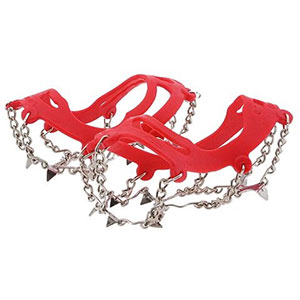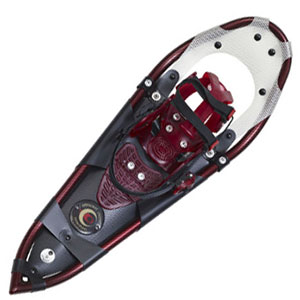Winter Traction
The problem of winter flotation and traction has obviously vexed humankind since the Ice Age. The biggest difference between three-season and winter hiking is the walking surface. Snow and ice require traction aids such as snowshoes, crampons, or hybrid traction devices. Snowshoes provide flotation so you can walk on top of snow and not sink with each step, an exhausting experience known as post-holing. Crampons and traction devices provide extra grip for walking on ice and compacted snow. They take up where snowshoes leave off and many winter hikers carry both types of traction on day hikes or overnight trips into the winter backcountry.
Traction Devices
Lightweight traction devices typically feature short cleats, attached to an elastic band that you slide over your shoes or boots. Many winter hikers use these lightweight traction devices for hikes that require scrambling over ice-covered rock. When purchasing, look for durability and compatibility with all types of winter footwear.
If you want to use softer shoes (like trail runners) in winter — whether for trail running or racing, or simply because they're lighter than boots — you should consider these hybrid traction devices that are designed for less traditional winter footwear. Other designs include instep crampons and titanium hobnails you can screw into those soles of your shoes or boots.
Learn more: Traction device reviews
Crampons
While lightweight traction devices are great for walking on icy trails, they don't provide sufficient traction for climbing and descending steep, ice-covered slopes. These conditions require crampons, a more aggressive traction device that has longer and sharper spikes and can penetrate into ice and give you a better foothold. You can choose among different types of crampons depending on your desired activity and the type of footwear you use. The general rule of thumb is that stiffer-soled boots are required for hiking or climbing steeper, more challenging terrain.
Learn more: Crampon reviews and buying advice
Snowshoes
If you're relatively new to the winter hiking scene and plan on hiking in fresh snow, you should probably buy a pair of snowshoes before investing in any other type of winter traction. In addition to providing flotation, modern snowshoes have metal teeth on their undersides, helping you to hike up hills on fresh snow or packed trails. Most snowshoe manufacturers offer a wide range, with models designed for everything from recreational snowshoeing to full-blown mountaineering.
Learn more: How to Choose Snowshoes



